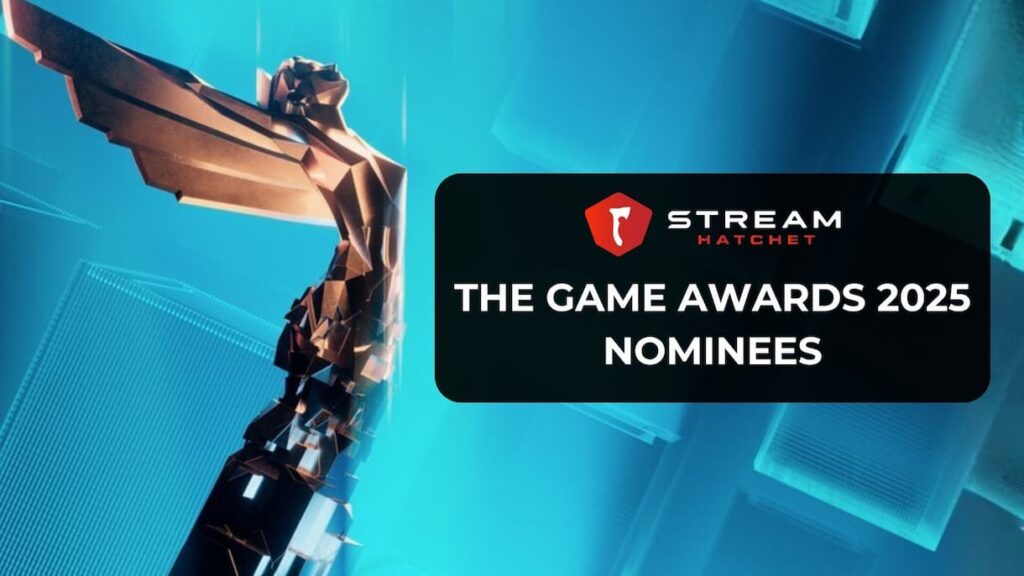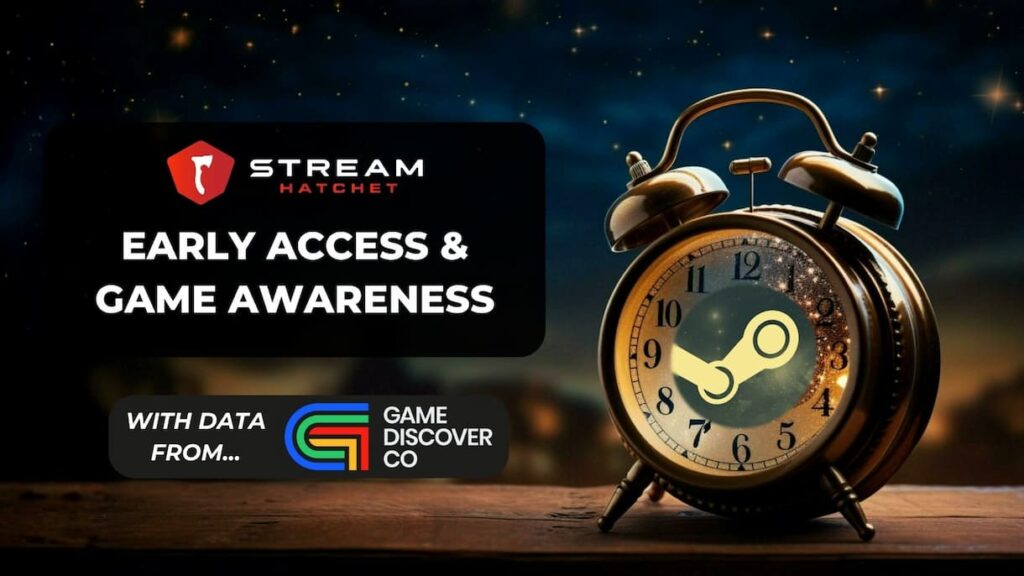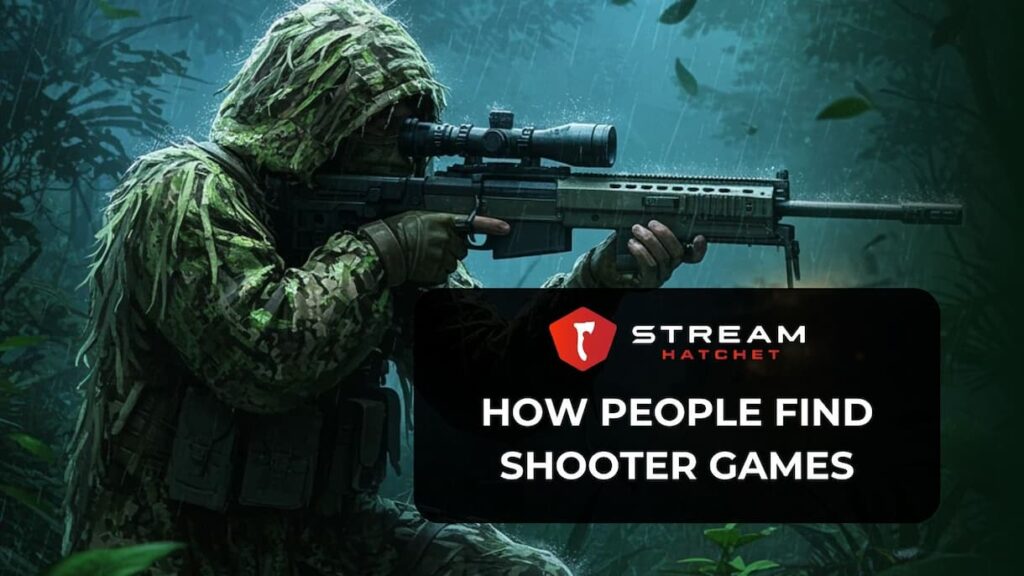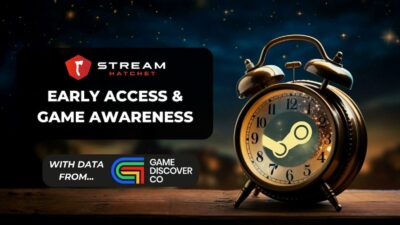The past decade has been ruled by live service games. Even as the popularity of battle royales, MOBAs, and shooters fluctuates, they all tend towards the live service model to generate money from their player base. But with so much variety between live service titles, the label demands further examination.
Live service games might be better described as “Games as a Service” (GaaS). Just like Software as a Service (SaaS), GaaS are hosted online, and require the user (or player) to access the game via an active connection to the internet. They then turn a profit by charging the player for continued access to part or all of the game. This ongoing supply allows developers to continuously add new content to the game and theoretically make the game infinitely playable
In this article, we’re looking at how this seemingly ideal innovation for both developers and gamers has come under fire from online critics, even while the popularity of live service games seems more assured than ever. Crucially, we’ll look at how sponsors and developers can take advantage of the live service game model to collaborate with one another and cross promote their products.
Four Key Points About Live Service Games:
- A Brief History of Live Service Games
- Live Service Games on Live Streaming Platforms
- Live Service Games vs. Boxed Games
- Different Live Service Game Models
One of the most powerful tools at your disposal is information: Access Stream Hatchet’s in-depth repository of streaming data to see the popularity of various games on Twitch and current trends among popular streamers.
A Brief History of Live Service Games
Live service games have their origins in MMOs from the early 2000’s, most prominently Blizzard’s World of Warcraft which charges players a monthly subscription fee to retain access to the game and its servers. Additionally, extra expansion packs require further purchases to radically transform the game and unlock new content. As the 7th console generation rolled around, consoles like the Xbox 360 and PlayStation 3 also gained the ability to release DLC to their users after a game’s release (like map packs for Halo: Reach). Borderlands further foreshadowed live service game genres back in 2009 by blending together RPG, shooter, and co-op mechanics
These disparate ideas finally coalesced at Sony’s E3 press conference in 2010, when Valve CEO Gabe Newell announced his vision of games as a service in the new decade. It took another three years to see the results of this plan, with GTA Online and Warframe launching in 2013 and taking the live service game model beyond traditional MMOs. The 8th console generation ran with the idea, and in 2017 two of the most popular contemporary live service games launched and solidified the model’s dominance: Fortnite and PUBG.
Live Service Games on Live Streaming Platforms
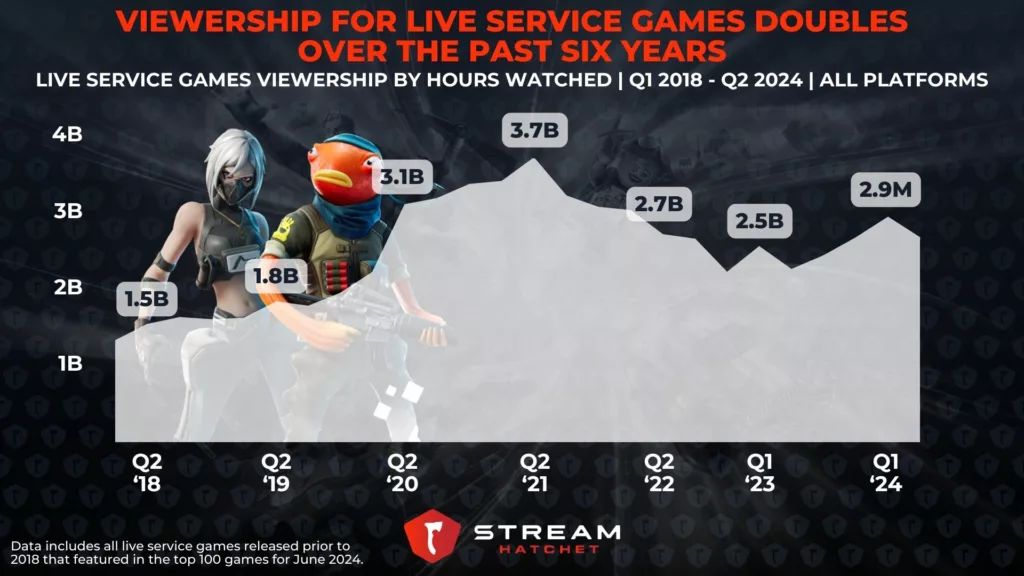
To evaluate the growth in demand for live service games on live streaming platforms, Stream Hatchet conducted a six-year analysis of the viewership for live service games that both a) featured in the top 100 games for June 2024 and b) were released prior to 2018. This covers many of the most prominent live service games, including Dota 2, Counter-Strike, and Fortnite. When considering the viewership of these games, the model’s immense popularity becomes clear: Live service game viewership doubled from 1.3B hours watched in Q1 2018 to just over 2.6B hours watched in Q2 2024.
The rise has been fairly consistent over the past six years, with one expected aberration: The effect of COVID. All games got a boost in live-streaming viewership from COVID as users flocked to platforms to fill up their time. Live service games are theoretically no different, but were undoubtedly helped by their (mostly) cooperative gameplay. Isolated individuals craving social contact with their friends no doubt drove up these live service games’ player bases, therefore driving interest in the games on live-streaming platforms.
Live Service Games Vs. Boxed Games
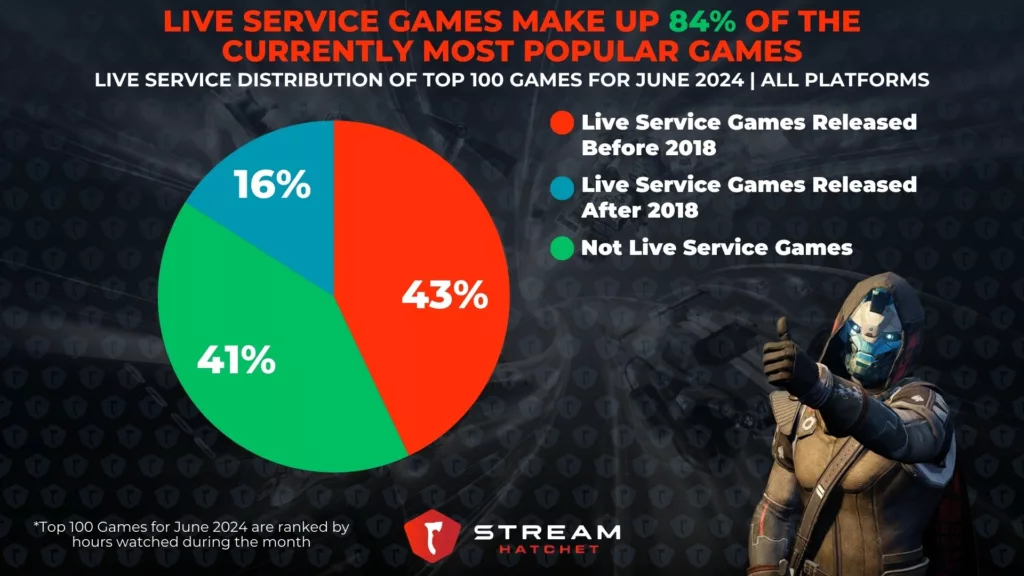
Live service games have mostly taken over from the more traditional “boxed game” model – games that are released in a finished, finite form and (rarely) receive future updates. Of the top 100 games in June 2024, just 16% of all titles were boxed games. These included Elden Ring, Pokémon Scarlet/Violet and Baldur’s Gate 3. Even more recently-released live service games performed better, with live service games released after 2018 accounting for 41% of all titles on the list.
A number of factors make live service games better suited to live-streaming platform viewership. The constant flood of updates keeps viewers coming back to platforms to catch up on the latest news and see their favorite streamers tackle new challenges. Live service games also push out constant marketing to maintain their concurrent player base (without which they fade into obscurity), and this marketing reminds viewers to tune back into live-streaming platforms. Lastly, live service games pair well with Twitch Drops campaigns that offer in-game loot to loyal viewers.
If you’re interested in planning your own Twitch Drops campaign, speak with a Stream Hatchet Consultant:
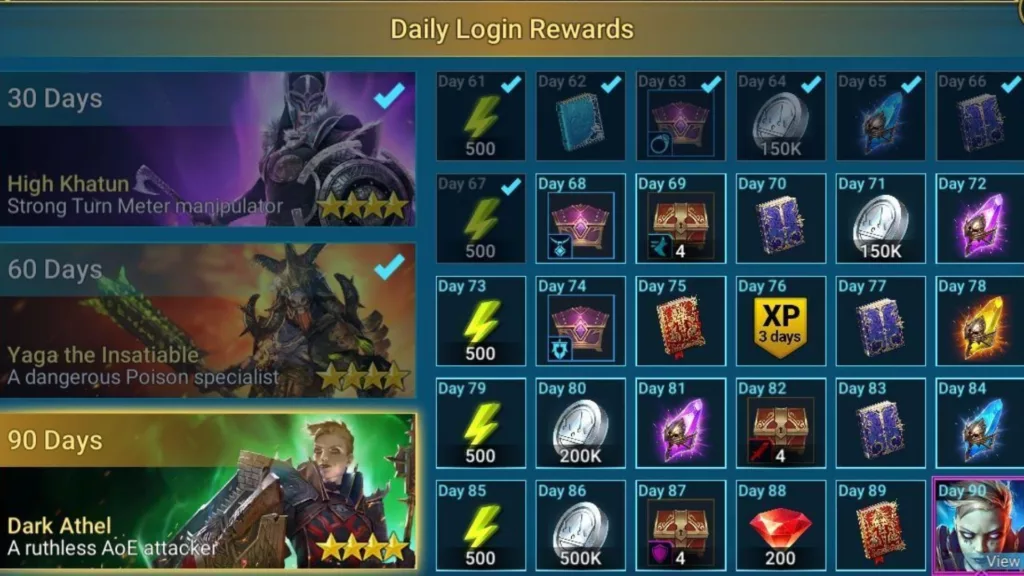
Despite these advantages, critics of live service games believe that the tactics they use to retain players and viewers are predatory. Daily login rewards, for example, encourage consistent devotion to a game, but feed off addiction rather than enjoyment. Additionally, many games thoughtlessly adopt the live service model to drive retention and profit without any concrete plans to release meaningful content in the future. The exploitation of the live service model’s versatility and addictive mechanisms mirrors the explosion of RPG elements in video games that hook players through the appeal of making their stats higher rather than satisfying gameplay.
Most likely as a result of these factors, 95% of game studios are planning or actively working on live service games. Former Halo and Destiny producer Joe Tung backs this industry shift however, claiming that live service games are actually better for the player. Tung recalls the era of E3 expos where a boxed game would have flashy features shoehorned into the demo to drive up sales, despite there being no genuine intention on the developers’ parts to include said features in the final product.
Different Live Service Game Models
While online sentiment and critical opinion towards live service games is generally negative, it’s worth remembering that even within live service games there are various different models for monetization that address the aforementioned issues.
MMOs began this live service model by generating their profit from subscription fees. This practice began even before World of Warcraft with Everquest back in 2000. Although subscription fees are a minority case now, a few massive MMORPGs still use the system, such as Final Fantasy XIV. Subscription fees are generally well-tolerated by players, but leave little room for tweaking by developers.
Much of the same can be said for games that feature on game subscription services, such as Xbox Game Pass and PlayStation Now. These services charge a flat fee to users and in exchange, they receive access to any new games released onto the service. The only concern from industry insiders is that games released onto, say, Xbox Game Pass, have their sales figures crimped which, to executives, indicates a less popular game. This can harm the franchise potential of well-loved games such as Hi-Fi Rush.
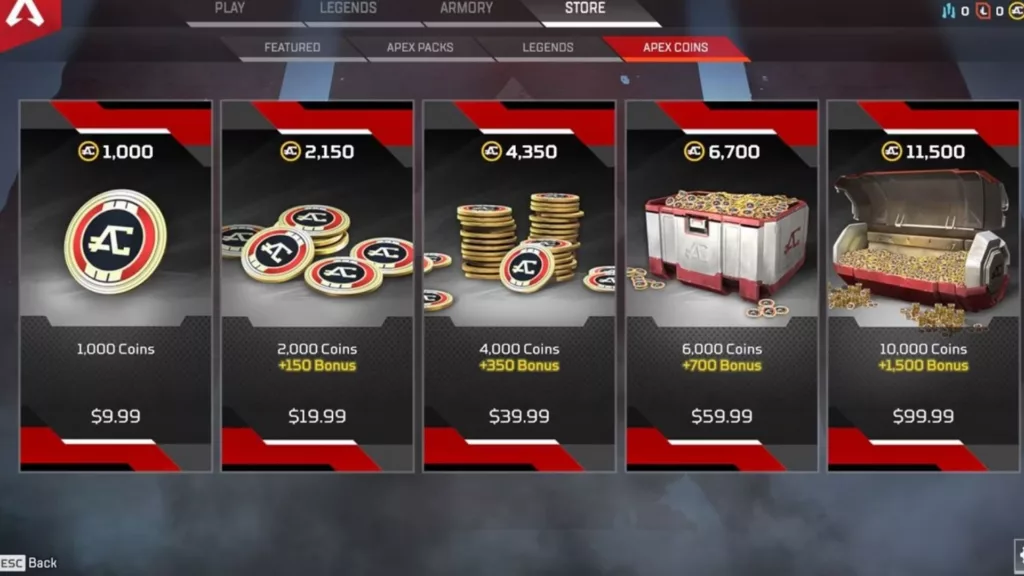
Microtransactions are the most widely panned monetization system for a live service game. These in-game purchases provide the player with cosmetics, stat boosters and items that speed-up their progress through the game. Apart from player complaints of pay-to-win gameplay, these microtransactions also become addictive when paired with loot box mechanics. As a result, Belgium even attempted to ban loot boxes back in 2018. However, when implemented responsibly, microtransactions can be a great way for players to support their favorite game with small “status” purchases (such as champion skins in League of Legends).
Microtransactions also offer a fantastic chance for brand integration into games, providing an additional revenue stream for developers to create new content and maintain their servers. To find sponsors that might be interested in a microtransaction-focused partnership, speak with a Stream Hatchet consultant today:
The more modern replacements for microtransactions in many AAA games are Season Passes or Battle Passes. Developers carve up their gameplay release calendar into different seasons with various events, and they then offer Passes to players who would like to gain exclusive rewards by playing during the season. These Passes can still be addictive, but at least they reward players for their effort in the game rather than sheer finances. Diablo IV is a recent example of this strategy, utilizing Battle Passes alongside new season content.
Finally, there’s one more type of live service model: Online-only game add-ons. These are essentially online versions of the base game that turn typically single player experiences into MMOs. These are brilliant ways to reuse assets from the base game to resourcefully create an MMO experience – but of course, this treatment is only well-suited to a handful of titles. GTA V’s online add-on GTA Online is one prominent example, being the most popular game on live-streaming platforms.
While these are the main types of live service game, it’s worth mentioning that the definition continues to be blurred by new titles. Helldivers 2, for example, offers a mid-way point between live service and boxed games in which players pay $40 upfront, but also receive live service benefits. Nintendo opts for a modified Season Pass idea for its multiplayer titles like Mario Kart 8 Deluxe and Super Smash Bros. Ultimate in which players paid a one-time fee to receive new DLC as it drops.
Amongst these many models, there are a variety of revenue opportunities for potential sponsors to capitalize on and multiple ways for developers to receive money from fans of their game. Live service games offer too many opportunities for profit to go away any time soon, so being aware of their popularity on live-streaming platforms is the key to promotional success.
Stream Hatchet provides the data needed to navigate the Twitch gaming landscape:
- Learn which streamers are playing which games to better target your campaigns
- Gain insights into your viewership data to better negotiate with streamers and sponsors
- Explore the effectiveness of your social media campaigns to better understand what marketing strategies are reaching your audience
- Track the performance of live service games and gain insight into the audience demographics for specific events
To get the edge in the streaming arena, sign up to Stream Hatchet now and a sales representative will be in touch to design your personalized demo:


